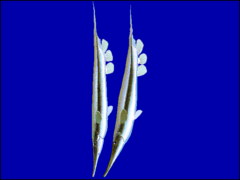Shrimpfish
| Shrimpfish | |
|---|---|
 |
|
| Aeoliscus strigatus | |
| Scientific classification | |
| Kingdom: | Animalia |
| Phylum: | Chordata |
| Class: | Actinopterygii |
| Order: | Syngnathiformes |
| Family: | Centriscidae |
| Subfamily: | Centriscinae |
| Genera and species | |
|
See text
|
|
Shrimpfish, also called razorfish, are five small species of marine fishes in the subfamily Centriscinae of the family Centriscidae. The species in the genera Aeoliscus and Centriscus are found in relatively shallow tropical parts of the Indo-Pacific, while the banded bellowsfish, which often is placed in the subfamily Macroramphosinae instead, is restricted to deeper southern oceans.
Shrimpfish are nearly transparent and flattened from side to side with long snouts and sharp-edged bellies. A thin, dark stripe runs along their bodies. These stripes and their shrimp-like appearance are the source of their name. They swim in a synchronized manner with their heads pointing downwards. Adult shrimpfish are up to 20 cm (7.9 in) long, including their snouts. The banded bellowsfish more closely resembles members of the subfamily Macroramphosinae (especially Notopogon) in both behaviour and body shape, and reaches a length of up to 30 cm (12 in).
Aeoliscus strigatus "looks like a long shrimp, or a little like a cut-throat razor — which accounts for its other name of razorfish. It is covered with a transparent armour which, my colleague George Barlow who has watched them in the wild tells me, even feels like that of a shrimp. The resemblance to a shrimp is probably, however, no part of their camouflage. Like many teleosts, shrimpfish swim around in co-ordinated groups, and with military synchrony. But unlike any other teleost you might think of, shrimpfish swim with the body pointing straight down. I don't mean they swim in a vertical direction. They swim in a horizontal direction, but with the body vertical. The whole effect of this synchronised swimming is a resemblance to a stand of weeds, or, even more strikingly, to the tall spines of a giant sea urchin, among which they often take refuge. Swimming head down is a deliberate decision. When alarmed, they are perfectly capable of flipping into more conventional, horizontal mode and they then flee with surprising speed."
The razorfish uniquely adopts a head-down tail-up position as an adaptation for hiding among sea urchin spines. It is generally found in coastal waters from the central Indian Ocean to the Red Sea to Hawaii. Its natural habitat includes beds of sea grasses and coral reefs, where sea urchins are found. The dorsal surface of the razorfish is covered by protective bony plates. They extend past the end of the golden-yellow body and over the tail fin, which terminates in a sharp spine. A dark band runs the length of the fish. The razorfish can grow up to 6 in (15 cm) in the wild.
...
Wikipedia
